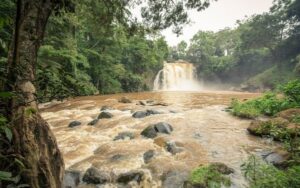Last week, I was privileged to witness President William Ruto preside over the Port Reforms Working Group Consultative Forum at the Berth 22 of the Port of Mombasa. In his speech, the President directly linked the productivity of our Port to the state of our economy and therefore stated why improving efficiency will help us create jobs, boost export volumes, and stimulate economic growth.
Indeed, ports can drastically boost a country’s economy. According to the World Shipping Council, China’s Shanghai Port is the largest port in the world. In 2021, it registered a container traffic of 47.03 million TEU (twenty-foot equivalent unit). This is a measure of volume in units of twenty-foot longcontainers. Six of the other top ten Ports were also from China. The other three were as follows: Singapore Port in second position; South Korea’s Busan Port in sixth position and Netherlands Rotterdam Port in tenth position.
It’s not by mistake that China is the world’s second strongest economy while South Korea is the tenth largest economy. To a certain extent, their port efficiency translates to the strength of their economies.
Meanwhile, Mombasa Port’s annual container traffic this year is projected to reach 1.48 million TEU, almost fifty times less than Shanghai Port’s 2021 traffic. Tellingly, there isn’t a single sub-Saharan African Port in the world’s top fifty ports. This is robbing Africa the financial boost that ports deliver.
Thankfully, as Kenya takes strides that will turn Mombasa Port into a world class port, I humbly suggest that we press hard on the following four things which are part of the 21 recommendations from the Port Reforms Working Group Consultative Forum. This will consequently inject more growth into the economy across Kenya and East Africa.
Firstly, we need to streamline the pre-arrival clearance. This is the first step towards enhancing cargo clearance and cargo off-take at the Port. Goods should arrive at to seamless process, not a clogged one that leads to unwarranted charges that are eventually transferred to end users.
Secondly, export processes should be most efficient because any slight delay affects ship turnaround time. Multiple agencies can’t continue placing holds on various consignments when the world is beckoning for goods from Africa.
Thirdly, we need to boost Mombasa Port’s transshipment capacity. Transshipment means unloading cargo from one vessel and loading them into another to complete a journey to the final destination. The Port of Singapore is the busiest transshipment port in the world and accounts for 20% of the globe’s transshipment traffic. Since time is money, transshipment rides on the back of speed and efficiency.
That’s why it was heartwarming to see President Ruto leading from the front when it comes to increasing Mombasa’s Port’s efficiency. As a case in point, he directed all Government related agencies operating at the Port to work for twenty-four hours, seven days a week to ensure that there is no procedure downtime.
Fourthly, we should reduce the number of weighbridges and police roadblocks along the northern Corridor. This will result in reduction of transit times along the Corridor, thus making it more competitive. We must keep in mind that landlocked countries like Uganda and Rwanda depend on us. The less time trucks bound for these countries spend on our roads, the more mutually beneficial business we shall be able to undertake with them. In this regard, the President’s directive to reduce the weighbridges from six to two and to remove all police roadblocks should be implemented with the urgency that it deserves.
In the same spirit of saving time and money for our long distance clients, we should harmonize the County cess fees levied by different County Governments. If we implement these four measures, alongside other various directives by President Ruto as recommended by CS Moses Kuria and his team, we will continue striding towards the efficiency exhibited by Ports like Shanghai and Singapore and our economy will greatly benefit. Think green, act green!



